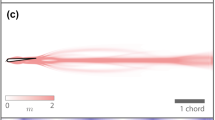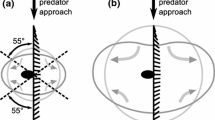
Overview
- Provides a comprehensive survey of our knowledge of flow sensory systems
- Covers morphological variations and function, spatial and temporal characteristics of natural flow stimuli, sensory transduction mechanisms, sensory processing by the peripheral and central nervous system, signal analysis, neuronal modeling and artificial flow sensors
- Written by experts
- Includes supplementary material: sn.pub/extras
Access this book
Tax calculation will be finalised at checkout
Other ways to access
About this book
In this book, leading scientists in the fields of sensory biology, neuroscience, physics and engineering explore the basic operational principles and behavioral uses of flow sensing in animals and how they might be applied to engineering applications such as autonomous control of underwater or aerial vehicles.
Although humans possess no flow-sensing abilities, countless aquatic (e.g. fish, cephalopods and seals), terrestrial (e.g. crickets and spiders) and aerial (e.g. bats) animals have flow sensing abilities that underlie remarkable behavioral feats. These include the ability to follow silent hydrodynamic trails long after the trailblazer has left the scene, to form hydrodynamic images of their environment in total darkness, and to swim or fly efficiently and effortlessly in the face of destabilizing currents and winds.
Similar content being viewed by others
Keywords
Table of contents (20 chapters)
-
Front Matter
-
Spatio-Temporal Structure of Natural Water and Air Flow Stimuli
-
Front Matter
-
-
Flow Sensing and Animal Behavior
-
Front Matter
-
-
Evolution and Development of Flow Sensors
-
Front Matter
-
-
Biomechanics and Physiology of Flow Sensors
-
Front Matter
-
Editors and Affiliations
Bibliographic Information
Book Title: Flow Sensing in Air and Water
Book Subtitle: Behavioral, Neural and Engineering Principles of Operation
Editors: Horst Bleckmann, Joachim Mogdans, Sheryl L. Coombs
DOI: https://doi.org/10.1007/978-3-642-41446-6
Publisher: Springer Berlin, Heidelberg
eBook Packages: Biomedical and Life Sciences, Biomedical and Life Sciences (R0)
Copyright Information: Springer-Verlag Berlin Heidelberg 2014
Hardcover ISBN: 978-3-642-41445-9Published: 04 February 2014
Softcover ISBN: 978-3-662-50963-0Published: 23 August 2016
eBook ISBN: 978-3-642-41446-6Published: 22 January 2014
Edition Number: 1
Number of Pages: XIII, 562
Number of Illustrations: 123 b/w illustrations, 77 illustrations in colour
Topics: Neurobiology, Biological and Medical Physics, Biophysics, Zoology



